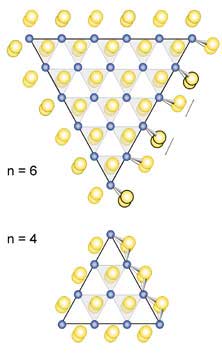| Posted: Jan 11, 2007 |
Properties of nanoparticles depend on cluster size |
|
(Nanowerk News Tiny variations in the numbers of atoms along the edges of molybdenum disulfide nanoparticles can profoundly influence the crystal's atomic-scale structure and coordination, electronic properties, and other characteristics, researchers in Denmark have shown. The findings may lead to improvements in MoS2-based desulfurization catalysts for fuel cleanup and to advanced lubricants and other applications.
|
|
With legislation in the U.S., Europe, Japan, and elsewhere calling for ever lower levels of sulfur in transportation fuels, scientists are redoubling their efforts to sort out the reaction mechanism that drives hydrodesulfurization, a process in which sulfur is stripped from hydrocarbons and converted to volatile hydrogen sulfide in the presence of MoS2-based catalysts.
|
 |
| STM analysis of triangular MoS2 nanoparticles (shown) reveals strong dependence of structure and other properties on the numbers of atoms along a crystal edge. (Mo is blue; S is yellow.) (Image: Sibylle Gemming)
|
|
Previous studies indicate that the edges of thin, supported MoS2 nanoclusters, which are often equilateral-triangular in shape, contain highly active catalytic sites, which are especially active when the clusters are very small. The high activity is often attributed to the unique coordination of edge atoms and the presence of reactive edge defect sites. But those features have not been explored in atomic-resolution detail until now.
|
|
On the basis of scanning tunneling microscopy (STM) measurements, Aarhus University physics professors Jeppe V. Lauritsen and Flemming Besenbacher and their coworkers at Aarhus and at catalyst manufacturer Haldor Topsøe have shown that nanoclusters with six or more molybdenum atoms along an edge coordinate sulfur differently than do nanoclusters containing fewer than six edge molybdenum atoms. Specifically, the team finds that along the edges of the larger crystallites, each Mo atom bonds with two outermost S atoms (S "dimers"), which tend to line up with neighboring atoms to form pairs of S "dimers." In contrast, the edges of smaller clusters exhibit Mo–S–Mo bridge structures ("Size-dependent structure of MoS2 nanocrystals"). The team also reports that the smaller clusters are less stable (more reactive) and more prone to vacancy defects than the larger clusters. And they note size-dependent differences in the clusters' STM signatures, which indicate the clusters' differing electronic structures.
|
|
In an accompanying commentary, Sibylle Gemming and Gotthard Seifert of the Technical University of Dresden, in Germany, note that the difference between the large and small nanoclusters "turns out to be the key to understanding the structural, electronic, and catalytic properties of these particles."
|

